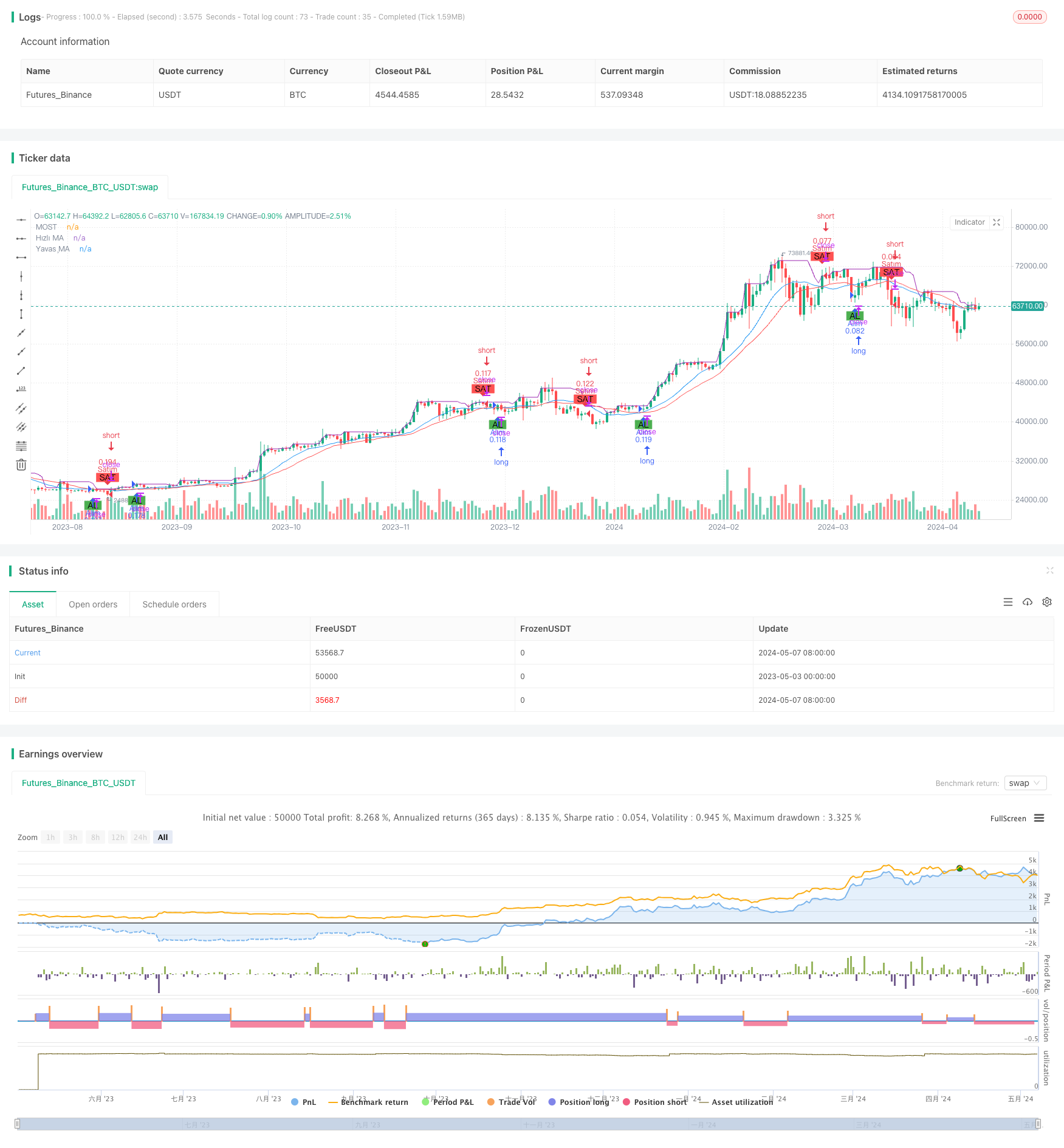
概述
MOST与双均线交叉策略是一种结合了多个技术指标的量化交易策略。该策略利用了两条不同周期的移动平均线(MA)的交叉信号,以及MOST指标对价格的超买超卖状态进行判断,从而产生买卖信号。当快速MA上穿慢速MA时产生买入信号,反之则产生卖出信号。同时,MOST指标用于确认价格的超买超卖状态,以避免在价格波动剧烈时频繁交易。
策略原理
该策略的核心是利用不同周期移动平均线的趋势特性,以及价格的超买超卖状态。具体来说:
- 计算快速MA和慢速MA。快速MA对价格变化更敏感,慢速MA则相对滞后。
- 判断快速MA和慢速MA的相对位置。当快速MA上穿慢速MA时,意味着价格可能进入上升趋势,此时产生买入信号;当快速MA下穿慢速MA时,意味着价格可能进入下降趋势,此时产生卖出信号。
- 利用MOST指标判断价格的超买超卖状态。当价格持续上涨并超过MOST指标时,意味着价格可能处于超买状态,此时应谨慎买入;当价格持续下跌并低于MOST指标时,意味着价格可能处于超卖状态,此时应谨慎卖出。
通过结合MA交叉信号和MOST指标,该策略能够较好地把握价格趋势,并避免在价格波动剧烈时频繁交易。
策略优势
- 趋势跟踪:通过利用不同周期MA的交叉信号,该策略能够较好地把握价格的中长期趋势。
- 减少噪音:通过结合MOST指标对价格超买超卖状态的判断,该策略能够有效过滤价格的短期噪音,避免频繁交易。
- 参数灵活:该策略的参数(如MA周期、MOST周期等)可以根据不同市场和品种进行灵活调整,以适应不同的市场特点。
策略风险
- 参数优化:该策略的表现依赖于参数的选择,如MA周期、MOST周期等。不恰当的参数可能导致策略表现不佳。因此,在实际应用中需要对参数进行优化。
- 市场适应性:该策略在趋势明显的市场中表现较好,但在震荡市场中可能表现不佳。因此,需要根据市场特点对策略进行调整。
- 滑点和交易成本:频繁的交易可能导致较高的滑点和交易成本,从而影响策略的净收益。因此,在实际应用中需要考虑这些因素。
策略优化方向
- 动态参数优化:可以考虑根据市场状态的变化动态调整策略参数,如在趋势明显时使用较长周期的MA,在震荡市场中使用较短周期的MA。
- 止损止盈:可以加入止损止盈机制,以降低单次交易的风险敞口。
- 仓位管理:可以根据市场波动性和风险偏好等因素动态调整仓位,以控制整体风险。
总结
MOST与双均线交叉策略通过结合不同周期MA的交叉信号和MOST指标对价格超买超卖状态的判断,能够较好地把握价格趋势,并避免频繁交易。该策略逻辑清晰,易于实现,并且可以根据不同市场特点进行灵活调整。但在实际应用中,需要注意参数优化、市场适应性、滑点和交易成本等因素。此外,还可以考虑加入动态参数优化、止损止盈、仓位管理等机制,以进一步提升策略的稳健性和盈利能力。
策略源码
/*backtest
start: 2023-05-03 00:00:00
end: 2024-05-08 00:00:00
period: 1d
basePeriod: 1h
exchanges: [{"eid":"Futures_Binance","currency":"BTC_USDT"}]
*/
//@version=5
strategy("MOST ve Hareketli Ortalama Kesişimleri", overlay=true, default_qty_type=strategy.percent_of_equity, default_qty_value=10)
// Girdi parametrelerini tanımlayın
fastMALength = input.int(title="Hızlı MA Uzunluğu", defval=14, minval=1)
slowMALength = input.int(title="Yavaş MA Uzunluğu", defval=21, minval=1)
mostLength = input.int(title="MOST Uzunluğu", defval=9, minval=1)
// Hareketli ortalamaları hesaplayın
fastMA = ta.sma(close, fastMALength)
slowMA = ta.sma(close, slowMALength)
// MOST'u hesaplayın
most = ta.highest(close, mostLength)
// Alım ve satım sinyallerini oluşturun
buySignal = ta.crossover(fastMA, slowMA)
sellSignal = ta.crossunder(fastMA, slowMA)
// Uzun ve kısa pozisyonlar için giriş koşulları
if (buySignal)
strategy.entry("Alım", strategy.long) // Alım sinyalinde uzun pozisyon girin
if (sellSignal)
strategy.entry("Satım", strategy.short) // Satım sinyalinde kısa pozisyon girin
// Göstergeleri ve sinyalleri çizin
plotshape(buySignal, title="Alım Sinyali", location=location.belowbar, color=color.green, style=shape.labelup, text="AL")
plotshape(sellSignal, title="Satım Sinyali", location=location.abovebar, color=color.red, style=shape.labeldown, text="SAT")
plot(fastMA, title="Hızlı MA", color=color.blue)
plot(slowMA, title="Yavaş MA", color=color.red)
plot(most, title="MOST", color=color.purple)
相关推荐